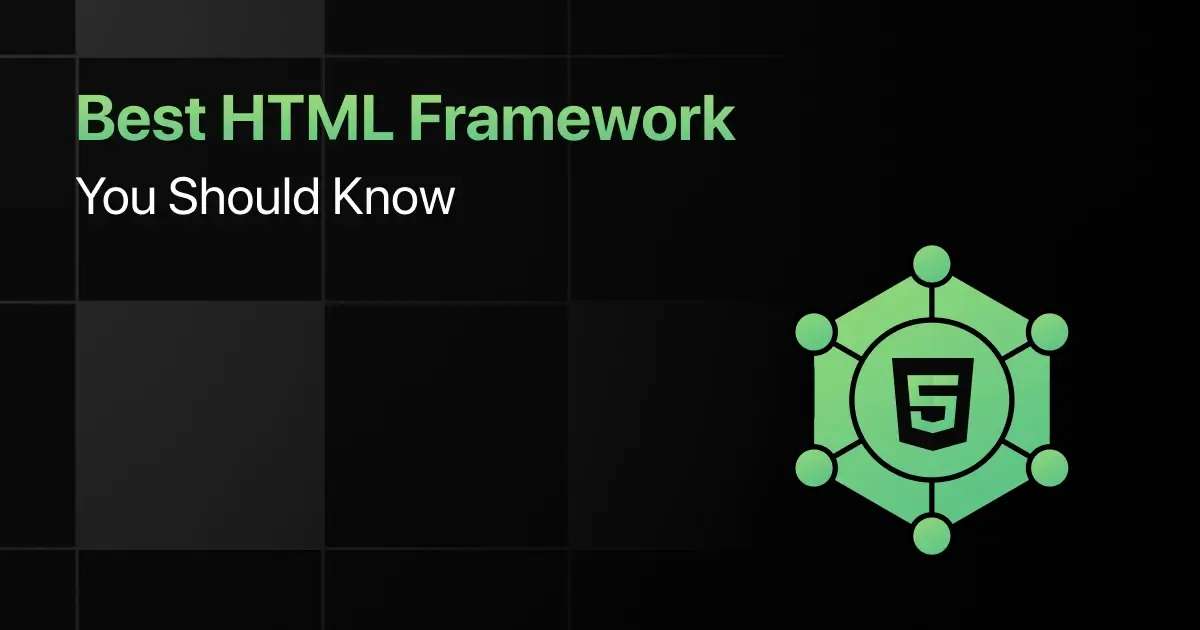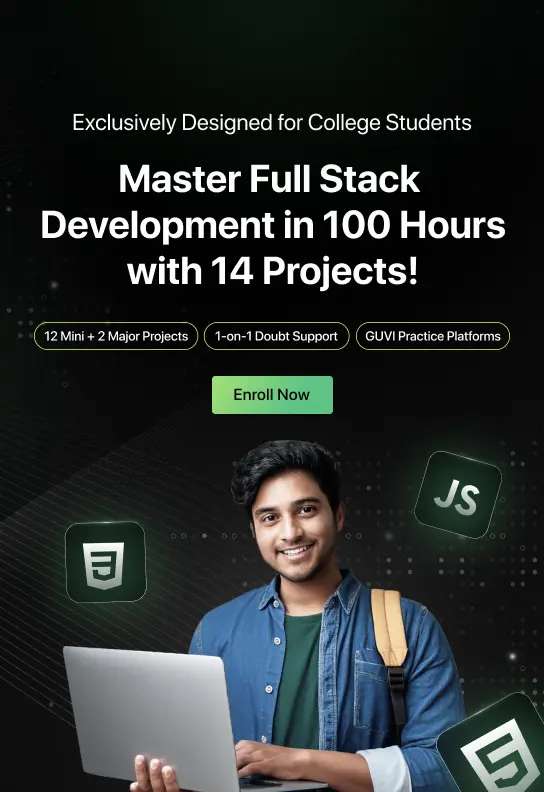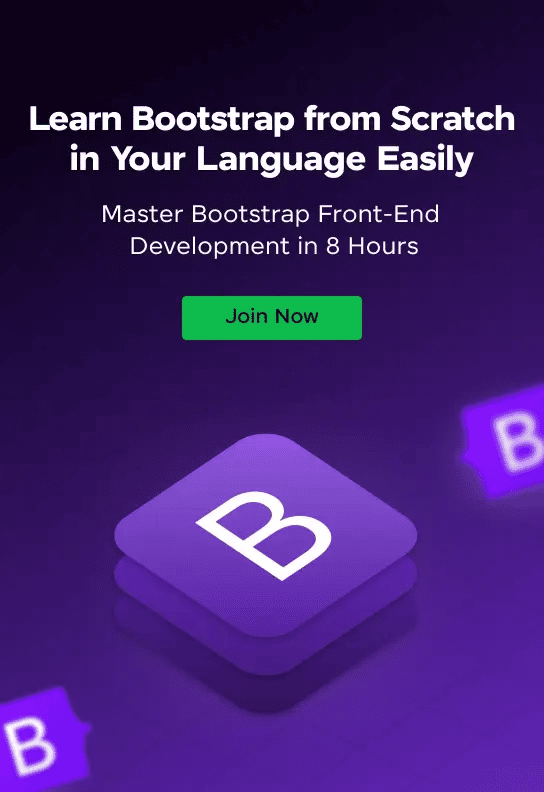Best HTML Frameworks You Should Know

HTML frameworks are essential tools for developers. They provide a structured foundation to build applications.
This blog will explore an HTML framework list and highlight the unique features of the best HTML frameworks and libraries.
If you’re looking for HTML frameworks for beginners or aiming to conduct a detailed HTML frameworks comparison, this guide has you covered.
Top HTML Frameworks for Developers – Overview
Here’s an overview of the 10 best frameworks for HTML:
| S.No. | Framework Name | Key Features | Ease of Integration | Download Link |
|---|---|---|---|---|
| 1 | Bootstrap | Responsive grid, Pre-styled components | Easy | Download |
| 2 | Foundation | Flexible, Robust JavaScript plugins | Medium | Download |
| 3 | Bulma | Flexbox-based, Pre-styled components | Easy | Download |
| 4 | Materialize | Material Design, Responsive grid | Easy | Download |
| 5 | Semantic UI | Semantic HTML, Theming support | Medium | Download |
| 6 | UIKit | Modular architecture, Pre-styled components | Easy | Download |
| 7 | Pure CSS | Minimalistic design, Responsive modules | Easy | Download |
| 8 | Skeleton | Minimalistic design, Responsive grid | Easy | Download |
| 9 | Spectre.CSS | Responsive design, Modern components | Easy | Download |
| 10 | Milligram | Minimalistic design, Responsive grid | Easy | Download |
Most Popular HTML Frameworks You Should Know
Below are the top 10 HTML frameworks you should know:
1. Bootstrap
Bootstrap is the most popular HTML, CSS, and JavaScript framework for developing responsive, mobile-first projects on the web.
It provides a robust set of design templates and components.
Popularity:
- Widely adopted in web development.
- Preferred by both beginners and experts.
- Used in many enterprise-level projects.
Key Features:
- Responsive grid system
- Pre-styled components
- Extensive documentation
Learning Curve: Easy
Performance: Good performance with optimized CSS and JavaScript
Compatibility:
- Works with all modern browsers.
- Integrates with various JavaScript libraries.
Ease of Integration: Easy
Use Cases and Industry Adoption:
- Responsive web design
- Prototyping
- Enterprise web applications
Job Market Demand:
- High demand in web development.
- Used by startups and large corporations.
- Preferred in UI/UX design roles.
2. Foundation
Foundation is a responsive front-end framework that provides a set of design templates and components to create responsive, mobile-first websites.
It is known for its flexibility and customization options.
Popularity:
- Popular in enterprise and large-scale projects.
- Widely used by experienced developers.
- Common in complex web applications.
Key Features:
- Responsive grid system
- Pre-styled UI components
- Robust set of JavaScript plugins
Learning Curve: Medium
Performance: Good performance with modular architecture
Compatibility:
- Compatible with all modern browsers.
- Works well with various JavaScript libraries.
Ease of Integration: Medium
Use Cases and Industry Adoption:
- Enterprise web applications
- Complex websites
- Responsive design
Job Market Demand:
- High demand in enterprise projects.
- Used by large corporations.
- Preferred for scalable web development.
3. Bulma
Bulma is a modern CSS framework based on Flexbox, providing a simple and responsive grid system along with various ready-to-use components.
It is known for its simplicity and ease of use.
Popularity:
- Popular among developers looking for simplicity.
- Widely used in small to medium-sized projects.
- Common in modern web design.
Key Features:
- Flexbox-based grid system
- Responsive design
- Pre-styled components
Learning Curve: Easy
Performance: Good performance with lightweight CSS
Compatibility:
- Works with all modern browsers.
- Integrates with various JavaScript frameworks.
Ease of Integration: Easy
Use Cases and Industry Adoption:
- Modern web design
- Responsive websites
- Small to medium-sized projects
Job Market Demand:
- Increasing demand in web design.
- Used by startups and small businesses.
- Preferred for rapid development projects.
4. Materialize
Materialize is a CSS framework based on Google’s Material Design principles, providing a modern and responsive design system for web applications.
It is widely used for creating visually appealing interfaces.
Popularity:
- Popular in projects needing Material Design.
- Widely used in modern web applications.
- Preferred by developers focusing on UI/UX.
Key Features:
- Material Design components
- Responsive grid system
- Pre-styled elements
Learning Curve: Easy
Performance: Good performance with optimized components
Compatibility:
- Works with all modern browsers.
- Integrates with various JavaScript libraries.
Ease of Integration: Easy
Use Cases and Industry Adoption:
- Material Design web applications
- Modern UI/UX design
- Responsive web development
Job Market Demand:
- High demand for Material Design projects.
- Used by tech companies and startups.
- Preferred in UI/UX design roles.
5. Semantic UI
Semantic UI is a CSS framework that uses human-friendly HTML to create responsive and themable designs, making it easy to understand and maintain.
It focuses on creating beautiful and consistent layouts.
Popularity:
- Popular in projects needing semantic HTML.
- Widely used in both small and large projects.
- Preferred by developers focusing on readability.
Key Features:
- Human-friendly HTML
- Responsive design
- Theming support
Learning Curve: Medium
Performance: Good performance with structured CSS
Compatibility:
- Works with all modern browsers.
- Integrates with various JavaScript libraries.
Ease of Integration: Medium
Use Cases and Industry Adoption:
- Semantic HTML projects
- Responsive web applications
- Themed websites
Job Market Demand:
- High demand for readable HTML/CSS projects.
- Used by startups and tech companies.
- Preferred for themable web applications.
6. UIKit
UIKit is a lightweight and modular front-end framework for developing fast and powerful web interfaces.
It provides a comprehensive collection of components and a simple, clean design.
Popularity:
- Popular in lightweight and modular projects.
- Widely used in modern web applications.
- Preferred by developers for its simplicity.
Key Features:
- Modular architecture
- Responsive design
- Pre-styled components
Learning Curve: Easy
Performance: High performance with modular components
Compatibility:
- Works with all modern browsers.
- Integrates with various JavaScript frameworks.
Ease of Integration: Easy
Use Cases and Industry Adoption:
- Modern web applications
- Modular web design
- Lightweight projects
Job Market Demand:
- Increasing demand in modular web development.
- Used by tech companies and startups.
- Preferred for lightweight and fast projects.
7. Pure CSS
Pure CSS is a minimal and responsive CSS framework that provides a set of small, responsive CSS modules that you can use in every web project.
It is designed to be fast and easy to use.
Popularity:
- Popular in minimalistic projects.
- Widely used for small to medium-sized projects.
- Common in projects needing minimal CSS.
Key Features:
- Minimalistic design
- Responsive modules
- Lightweight
Learning Curve: Easy
Performance: High performance with minimal footprint
Compatibility:
- Works with all modern browsers.
- Integrates easily with any project.
Ease of Integration: Easy
Use Cases and Industry Adoption:
- Minimalistic web design
- Small to medium-sized projects
- Rapid development
Job Market Demand:
- High demand in minimalistic web design.
- Used by startups and small businesses.
- Preferred for lightweight projects.
8. Skeleton
Skeleton is a simple, responsive CSS framework for quickly creating mobile-friendly web applications, offering a minimal set of styles.
It is designed to be lightweight and easy to use.
Popularity:
- Popular in small and simple projects.
- Widely used for prototyping.
- Common in a mobile-first design.
Key Features:
- Minimalistic design
- Responsive grid system
- Lightweight
Learning Curve: Easy
Performance: High performance with minimal styles
Compatibility:
- Works with all modern browsers.
- Integrates easily with any project.
Ease of Integration: Easy
Use Cases and Industry Adoption:
- Prototyping
- Mobile-first design
- Small web projects
Job Market Demand:
- High demand in rapid prototyping.
- Used by startups and small businesses.
- Preferred for mobile-first projects.
9. Spectre.CSS
Spectre.css is a lightweight, responsive, and modern CSS framework, designed to be flexible and easy to use.
It provides a clean and minimal design system.
Popularity:
- Popular in modern web development.
- Widely used in projects needing a clean design.
- Common in rapid development.
Key Features:
- Responsive design
- Modern components
- Lightweight
Learning Curve: Easy
Performance: High performance with clean design
Compatibility:
- Works with all modern browsers.
- Integrates with various JavaScript libraries.
Ease of Integration: Easy
Use Cases and Industry Adoption:
- Modern web design
- Responsive websites
- Rapid development
Job Market Demand:
- Increasing demand in modern web projects.
- Used by tech startups.
- Preferred for clean and lightweight design.
10. Milligram
Milligram is a minimal CSS framework that provides a clean starting point for responsive web design.
It is designed to be fast and efficient, with a small footprint.
Popularity:
- Popular in minimalistic and clean projects.
- Widely used for fast prototyping.
- Common in small to medium-sized projects.
Key Features:
- Minimalistic design
- Responsive grid system
- Lightweight
Learning Curve: Easy
Performance: High performance with minimal styles
Compatibility:
- Works with all modern browsers.
- Integrates easily with any project.
Ease of Integration: Easy
Use Cases and Industry Adoption:
- Minimalistic web design
- Fast prototyping
- Small to medium-sized projects
Job Market Demand:
- High demand in minimalistic and clean design.
- Used by startups and small businesses.
- Preferred for fast and efficient projects.
Final Words
For beginners, starting with the recommended HTML frameworks in this blog can ease your learning curve.
Mastering the top 10 HTML frameworks will equip you with the knowledge and tools needed to build scalable web applications.
Explore More HTML & CSS Resources
- HTML & CSS Learning Websites
- HTML & CSS Practicing Websites
- HTML & CSS YouTube Channels
- HTML & CSS Project Ideas
- HTML & CSS IDEs
- HTML MCQ
- CSS MCQ
Explore More Frameworks
- Java
- Python
- JavaScript
- C Programming
- CSS
- Web Development
- Mobile App Development
- Automation Testing
- PHP
- Machine Learning
- Unit Testing
- Big Data
- Ruby
- Data Science
- DevOps
- Blockchain
- Golang
FAQs
The best HTML frameworks to use are:
- Bootstrap
- Foundation
- Bulma
- Materialize
- Semantic UI
The key features you should look for in an HTML framework are responsiveness, pre-styled components, comprehensive documentation, and strong community support.
Bootstrap and Bulma are the easiest HTML frameworks to learn for beginners.
Common use cases include responsive web design (Bootstrap, Foundation), material design implementations (Materialize), and semantic web components (Semantic UI).
Some lightweight HTML frameworks for rapid application development are Skeleton, Pure CSS, and Spectre.css.
Top companies use Bootstrap, Foundation, and Materialize for their robust and scalable design systems.
There is a high demand for skills related to Bootstrap, Foundation, and Materialize in web development and front-end engineering roles.
Related Posts


How to Prepare for .Net Interview
Are you preparing for a .NET interview but not sure which topics to prioritize? Many candidates struggle to balance C# fundamentals, …
Warning: Undefined variable $post_id in /var/www/wordpress/wp-content/themes/placementpreparation/template-parts/popup-zenlite.php on line 1050










